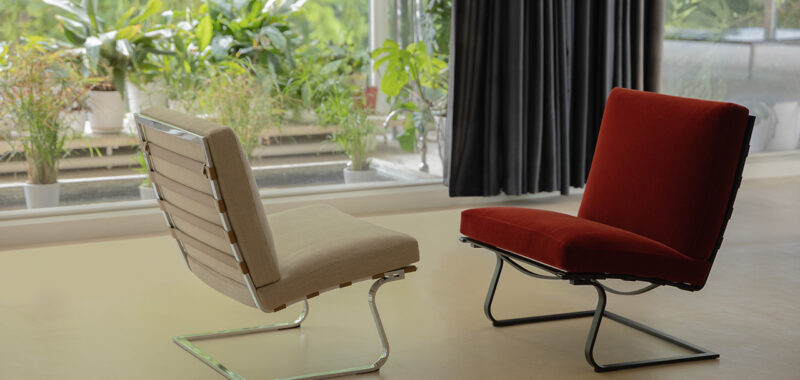The Tugendhat Chair is getting a new spotlight in 2024, thanks to Knoll. The 1929 archival icon was originally designed for Villa Tungendhat, located in Brno, Czech Republic, which was designated a UNESCO World Heritage Site in 2001. It was designed by Ludwig Mies van der Rohe and Lilly Reich as a “total work of art,” meaning the architecture, furnishings, decorations, and grounds were designed specifically for the project. The archival relaunch is celebrated by being photographed in the villa itself, a clear nod to its storied history.

The Tugendhat Chair itself is ahead of its time in many ways, utilizing the most cutting edge metalworking equipment to create the cantilevered form. A bit of a hybrid between the classic Barcelona Chair and the Brno Chair, the Tugendhat Chair utilizes flat bar steel to create the luxurious size and feel of a traditional lounge chair, yet also removing the entirety of the bulk from the floor, allowing the polished metal to reflect the light and color from the surrounding interior and garden. Other versions of the chair sport flat bar metal armrests as well, highlighting the luxurious yet inviting nature of the piece.

Originally produced by Knoll between the years of 1964 to 1979, the Tugendhat Chair was ahead of its time as its relaxed comfort is perfectly suited to how people currently live and work. “When you sit in the chair, there’s a gentle bounce, giving the design a dynamic spirit,” says Jonathan Olivares, Senior Vice President of Design.” It engages the user within the space in a way that influences how the entire interior feels to that person.”

Completed in 1930, the Villa Tungendhat was the first personal residence in Europe to be constructed from steel and poured concrete. Many facets of the structure, from materiality to composition, were well ahead of their time. The consideration of the grounds as not an afterthought, but an equal part of the full effect of the living experience, is not examined as thoroughly in modern architecture.

The designers took great care to erase as many visual and physical boundaries between the inside and outside, blending garden scenes and specific plants amongst the paneled glass and wrought steel. This process embodied the ideals of the Bauhaus movement. Gesamtkunstwerk, or “complete work of art,” was a principle of the Bauhaus that celebrated the wholeness of a project. A building and it’s architecture is only one facet in the jewel of space.

Highly unassuming from street level, Mies and Reich valued the privacy of the inhabitants greatly. The splendor of the house and grounds is revealed around back, sporting a beautiful garden that drapes seamlessly on to a travertine floor, greeting the viewer with a grand staircase. Traveling up the stairs, one is greeted by an airy, light-filled first floor.

This is one of the first open concept houses, delineating different areas by partitions placed across the floor plan. One of the first buildings to be completely air conditioned, this villa also boasts an electric window and shade system, over 80 years old at this point. The system allows the windows, spanning over five meters each, to descend to waist height, using the top rail as an armrest or a place to rest a drink.


The classic hidden entrance to Villa Tugendhat is very much in line with Mies’s ‘less is more’ approach, preferring to nestle the main entrance of the house behind a rotund frosted glass element rather than make the scene obvious. Greeted with lounge areas, bedrooms, and other areas, the entire house is outfitted with floor to ceiling doors. As one of the first open concept houses, it has less than most. During construction, building teams notoriously were wary to take on the responsibility of such an expensive project. But this was not negotiable by the designers, the doors now becoming panels, able to ventilate with a single swing.




As Knoll is known for the highest quality finishes and materials, the modern Tugendhat Chair is available in a multitude of colors and upholstery options. Each chair is certified with a Knoll stamp and the designer’s signature, ensuring lifetime authentication.



For more information and pricing on the historic Tugendhat Chair, visit Knoll.com.

